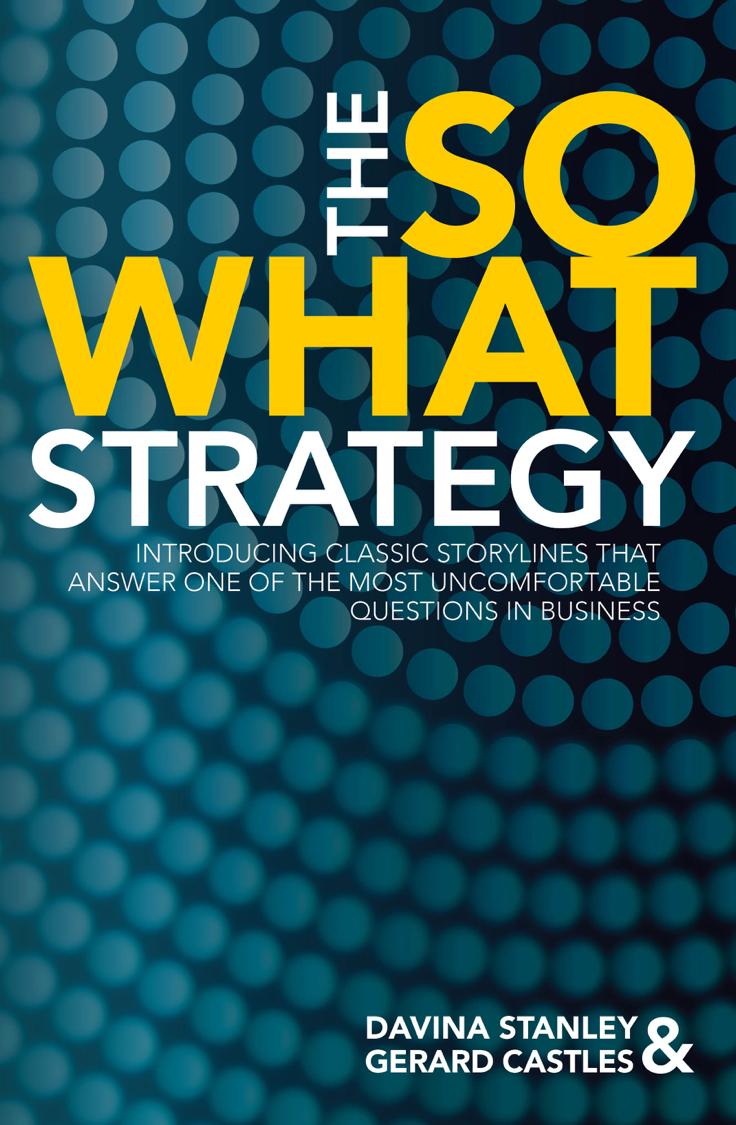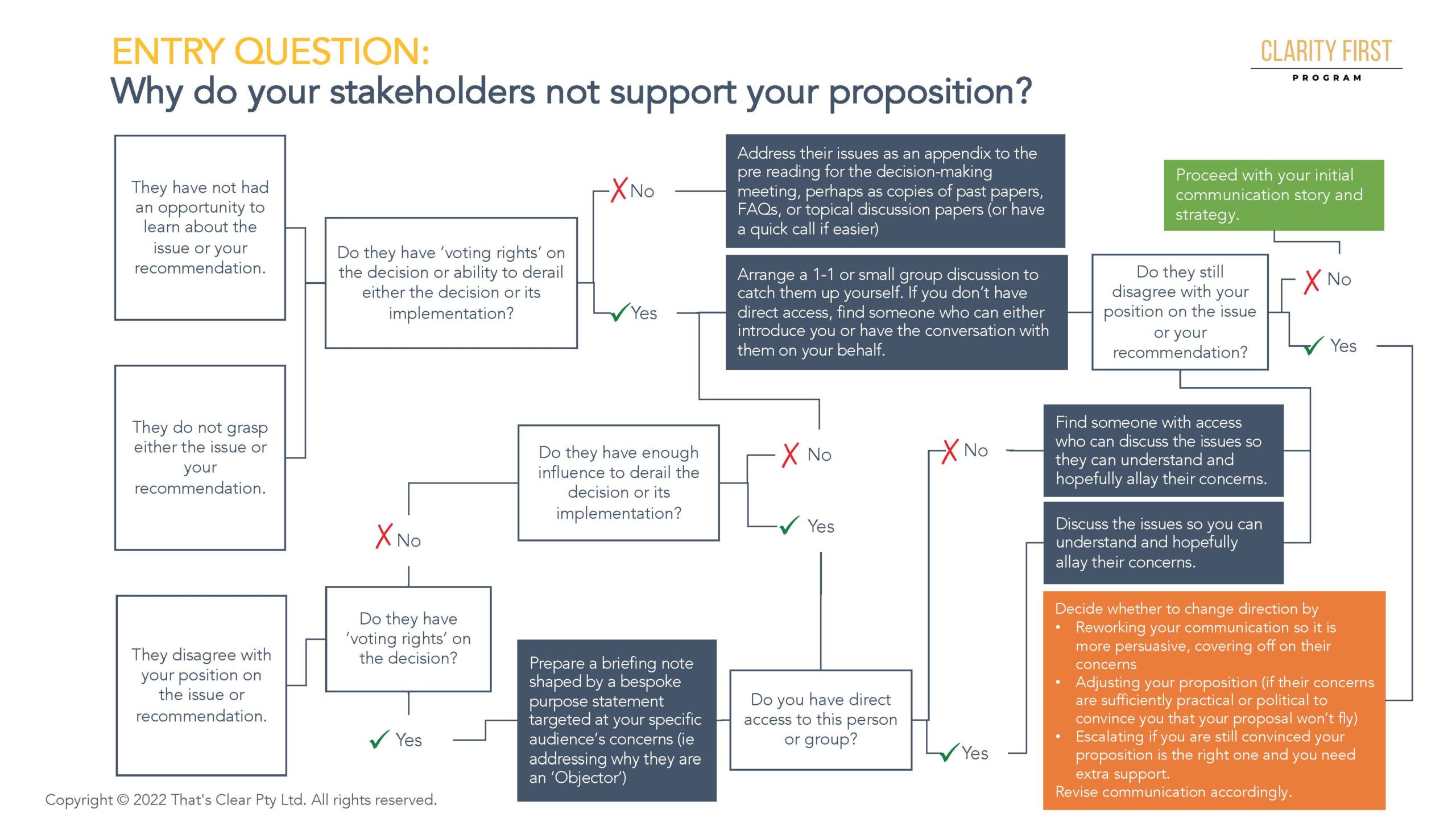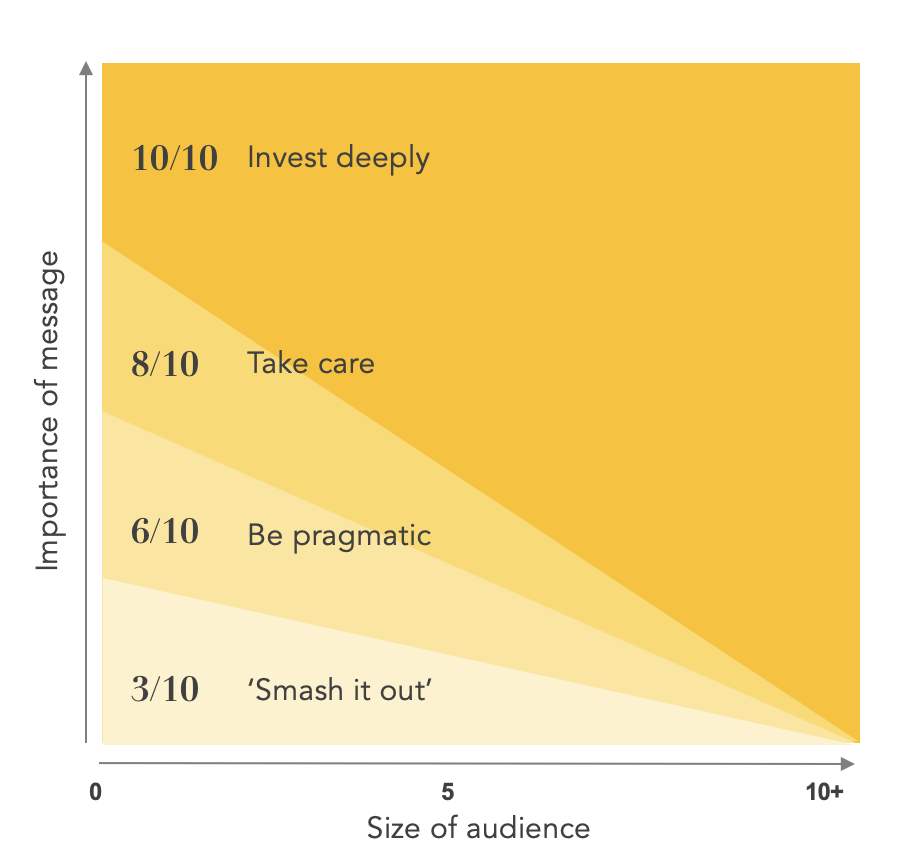×

LEARN MORE ABOUT THE WORKSHOP KIT
Enter your email below and we will keep you updated as more information is released about the kit.

Are you so close to your work that you lose sight of what it's all really for?
It's interesting to me how I for one forget the obvious.
I move forward forgetting that what is obvious to me is often not obvious to others.
I was again reminded of this today in an advanced workshop with one of my government clients.
We were using a ‘pattern flipping' technique, which involves some fairly sophisticated mental gymnastics.
We play with storyline patterns to create new ones that better frame the story we need to tell.
This is more helpful to this client than most because their stories are huge and incredibly complex.
So, here's the thing.
To make ‘flipping work', I have to see storylines as a thinking machine that helps me work out what my message is. They are not a template to fill in.
To me this is pretty ‘ho hum'.
Of course they are! I use them all day every day.
But to see the light turn on in my clients' eyes around this was magic.
Here's what happened. They did five things …
Stopped being so literal and started to think. They began focusing on how to tweak a pattern so it suited their purpose, rather than taking a quick look at the favourite seven and saying ‘that'll do'.
Began to lean into how a storyline structure can highlight thinking problems. They could find and fix thinking problems by testing the ‘rules' that hold the ideas together.
Went beyond ‘clarity' to deliver ‘insight'. They started drawing out powerful and insightful messages rather than delivering something accurate and on topic but not impactful.
Saw how much faster they went if they started slow. Although storylining can be time consuming and mentally taxing, they saw how much time they saved by slowing down enough to think at the start.
Realised how much more value they could deliver. Less time reworking papers, speaking to people who don't respond to emails or don't ‘get' the message they are conveying. Better clarity of message. Greater quality of insight. Greater velocity of business.
I hope that helps.
Warmly,
Davina

I love what I do.
I help senior leaders and their teams prepare high-quality papers and presentations in a fraction of the time.
This involves 'nailing' the message that will quickly engage decision makers in the required outcome.
I leverage 25+ years' experience including
My approach helps anyone who needs to engage senior leaders and Boards.
Recent clients include 7Eleven, KPMG, Mercer, Meta, Woolworths.
Learn more at www.clarityfirstprogram.com
(*) Numbers are based on 2023 client benchmarking results.

We talk a lot about the clarity of communication. To me that means how easy it is for a person in our audience to grasp what we are saying.
This is, I suggest, only ground level for powerful business communication.
The next level is to deliver a high-quality message. By my way of thinking this is a message that is not just clear, but which delivers significant value.
In most situations this requires a good degree of synthesis, and I thought sharing four key questions we ask might help you assess the quality of your own communication.
To test the quality of our messaging, we ask ourselves what level of message we have used.
I encourage you to review the three most recent pieces of communication you have prepared and assess what level your communication was at.
If you find very few level 4 messages ask yourself why and see if you can level them up in your next piece.
I hope that helps and look forward to bringing you more next week.
Davina

I love what I do.
I help senior leaders and their teams prepare high-quality papers and presentations in a fraction of the time.
This involves 'nailing' the message that will quickly engage decision makers in the required outcome.
I leverage 25+ years' experience including
My approach helps anyone who needs to engage senior leaders and Boards.
Recent clients include 7Eleven, KPMG, Mercer, Meta, Woolworths.
Learn more at www.clarityfirstprogram.com
(*) Numbers are based on 2023 client benchmarking results.

I didn't expect the results from my ‘quick and dirty' prose v PowerPoint survey to land where they did.
Let me share the findings and observations with you and draw my conclusion.
The findings – In asking people what communication form their organisations use for discussing important decisions, prose wins hands-down. Here are the results:
My observations – I was surprised at the degree of the skew toward prose given I am often asked to help people with their PowerPoint presentations. Two things stood out:
My conclusion – I guess I am not as alone as I thought in my growing concern about the challenges and potential ineffectiveness of PowerPoint.
I do think it's a useful tool, but increasingly agree with Jeff Bezos that it can get in the way of powerful messaging.
Kind regards,
Davina

I love what I do.
I help senior leaders and their teams prepare high-quality papers and presentations in a fraction of the time.
This involves 'nailing' the message that will quickly engage decision makers in the required outcome.
I leverage 25+ years' experience including
My approach helps anyone who needs to engage senior leaders and Boards.
Recent clients include 7Eleven, KPMG, Mercer, Meta, Woolworths.
Learn more at www.clarityfirstprogram.com
(*) Numbers are based on 2023 client benchmarking results.

I had a fabulous question this week: where do we fit ‘pros' and ‘cons' in our storyline?
That is a ‘ripper' of a question.
My answer is this: lists of pros and cons don't belong in your communication, they help you think through that message.
Let me explain.
If we provide lists of pros and cons for an idea, we are providing information rather than insight. This matters, because in taking this approach we
If, instead, we do the thinking for our audience, we will deliver insights that emerge from our own analysis of the pros and cons list.
Although more intellectually challenging, this is better for us and our audience. We know more about the area than they do and we don't miss the opportunity to share our value add.
If your audience is explicitly asking for pros and cons lists, pop them in the appendix. Focus your main communication around your interpretation of that list.
Hopefully next time they won't ask for the list, but rather for your insights.
I hope that helps.
Kind regards,
Davina

I love what I do.
I help senior leaders and their teams prepare high-quality papers and presentations in a fraction of the time.
This involves 'nailing' the message that will quickly engage decision makers in the required outcome.
I leverage 25+ years' experience including
My approach helps anyone who needs to engage senior leaders and Boards.
Recent clients include 7Eleven, KPMG, Mercer, Meta, Woolworths.
Learn more at www.clarityfirstprogram.com
(*) Numbers are based on 2023 client benchmarking results.

Love or hate Jeff Bezos, he has had some very very good ideas when it comes to decision making communication.
I was talking about one of these with a client earlier this week. Given she liked the ideas and planned to implement them, I thought I'd share them with you also.
The most prominent idea relates to avoiding PowerPoint in favour of tightly crafted prose narratives to maximise quality decision making. Let me explain the two key ideas my client found so useful.
Avoid PowerPoint presentations. In relying on Edward Tufte's work on visualising information, ‘Jeff' decided to ban PowerPoint for reasons that seem sound to me.
Here's what they do instead.
Rely on short, tightly crafted prose narratives instead. They don't insist on any particular way of writing these, just that they be short and effective in setting up a great discussion. Their use in meetings is, however, prescribed as follows. The papers are
I hope that provides some useful food for thought.
Kind regards,
Davina
PS – I am curious to see what tools your organisations use.
If you click the relevant link below, I'll see the tally and can factor this into my program design for you.
In my organisation, decision making papers are …
When you click the link it will take you to a post on my website that offers some ideas on different ways to think about communication.
I'll let you know the results next week.
May 27th
Moving away from PowerPoint shines a light on the need to craft a really crisp narrative.
We can no longer hide or ad lib: we must think hard to connect the dots between our ideas no matter how complex the material.
Learn the foundational skills for untangling complex ideas so you can move from delivering ‘information' to conveying insightful, high-quality messages that are easily understood.

This week I received two requests to help with presentation skills, one for a finance professional and one for a group of about 80 analysts.
In both cases presentation skills were not the main issue.
In my opinion, they were just ‘tip of the iceberg'.
The real problem lies in synthesising findings into a clear, insightful, outcome-oriented message.
Let me explain with a diagram and then the back story.

From what I could see, the issue that I was being asked to solve: ‘standing with confidence' and ‘projecting their voice', were the least of their problems.
In both cases, presenters lost confidence when they received the wrong kinds of questions that led to the wrong kinds of discussions … and slow or no decisions.
When messages are not well synthesised decision makers ask questions that help them understand the message. This often involves diving into minute detail as decision makers attempt to do the thinking work themselves.
I see this most when recommendations are buried among a long series of facts. It forces decision makers to connect the dots between the facts, which leads them to lose the thread. This in turn leads them to ask questions to clarify the message rather than discussing the issue.
Conversations become convoluted, at times feeling more like an interrogation than a discussion. They also rarely lead to a high-quality or fast decision.
This is frustrating for all concerned and why I prioritise thinking skills.
I teach you to connect the dots into a well-synthesised message, so your audience doesn't have to.
I regularly hold a Thinking Skills MasterClass to uncover the skills essential to synthesising powerful messages.
This will then help you receive the right kinds of questions … and enjoy greater confidence when presenting your ideas in any forum.
Kind regards,
Davina

I love what I do.
I help senior leaders and their teams prepare high-quality papers and presentations in a fraction of the time.
This involves 'nailing' the message that will quickly engage decision makers in the required outcome.
I leverage 25+ years' experience including
My approach helps anyone who needs to engage senior leaders and Boards.
Recent clients include 7Eleven, KPMG, Mercer, Meta, Woolworths.
Learn more at www.clarityfirstprogram.com
(*) Numbers are based on 2023 client benchmarking results.

This is an unusual post but one I hope will help.
I just responded to a post by an old friend, Dr James Muecke who happened to be Australian of the year in 2020 for his work fighting sugar.
Look at how well he simplified and shared the message ….
Great (cheeky?) use of humour – Zits away …?
Demonstrates credibility – This recent systematic review concludes that “high glycemic index, increased glycemic load, and carbohydrate intake have a modest yet significant proacnegenic effect.”
Simple and visual summary – In other words, sugar => pimples
Clear takeaway that had me thinking about the young people in my own family – This might just motivate your kids to reduce their sugar intake …
Although I would have reordered these points for greater impact, I was thoroughly impressed by the simplicity and the timing (given many of us are about to binge on chocolate during Easter!).
I hope that helps.
Kind regards,
Davina


I love what I do.
I help senior leaders and their teams prepare high-quality papers and presentations in a fraction of the time.
This involves 'nailing' the message that will quickly engage decision makers in the required outcome.
I leverage 25+ years' experience including
My approach helps anyone who needs to engage senior leaders and Boards.
Recent clients include 7Eleven, KPMG, Mercer, Meta, Woolworths.
Learn more at www.clarityfirstprogram.com
(*) Numbers are based on 2023 client benchmarking results.

I came to Friday's interview with Matt Lohmeyer a bit selfishly. Negotiating has often made me nervous and yet he seems to thrive while discussing and doing it.
So, I wanted to learn how he gets great outcomes while actually enjoying the process.
If I am to interpret Matt correctly, the ‘insight' is to explore ‘possibility’ and seek out ‘opportunity’ rather than be driven by the fear of being cornered by a win/lose proposition.
Here are three fear busters that I took away that I hope help you also.
Let me now give you some more detail about these before offering the video recording and two powerful and free tools from Matt.
1 – Deal with the hairy beasts first. By that, Matt suggests dealing with the most difficult issues of a negotiation first. He recommends agreeing the negotiation strategy at the beginning as a way to build rapport, rather than dealing with small items. An example might help.
At the beginning you might ask the other person (note, I am deliberate in not saying ‘the other side') to identify their biggest concern. You might even suggest that you think item X is going to be the most difficult thing to resolve.
This gives them an opportunity to agree or to indicate that item Y or Z is a bigger deal for them. Taking this approach offers many advantages. You
2 – See popular techniques as tools rather than the primary strategy. Matt suggests that emphasising win-win solutions or splitting the difference results in mediocre outcomes. Why?
Because they leave you thinking small. They lead you to
3 – Avoid saying no, and frame your response as a possible alternative. This doesn't mean NEVER saying no as Matt was quick to point out, but rather avoid saying it.
To give an example. Instead of saying ‘No, I can't have coffee with you tomorrow afternoon', say ‘I could have coffee with you at 9am tomorrow at a location near me'.
This then puts the onus back on the other person to decide whether they will make the extra effort to make that time and location work.
This is a simple example, but a powerful principle that empowers me by offering a constructive way out.
These are just some of the gems that Matt shared. You can visit the recording below as well as download two powerful resources he has for us all.
1. A diagnostic to help you calibrate your personal blend of preferred negotiation strategies with the norm group of over 2,500 other executives. How do you actually negotiate? To unlock this tool, you will need to use the password Mythbusters.
2. A generously detailed PDF full of negotiation strategies for you to employ – register below to receive access to Matt's eBook:
Kind Regards,
Davina

I love what I do.
I help senior leaders and their teams prepare high-quality papers and presentations in a fraction of the time.
This involves 'nailing' the message that will quickly engage decision makers in the required outcome.
I leverage 25+ years' experience including
My approach helps anyone who needs to engage senior leaders and Boards.
Recent clients include 7Eleven, KPMG, Mercer, Meta, Woolworths.
Learn more at www.clarityfirstprogram.com
(*) Numbers are based on 2023 client benchmarking results.

I was a bit nervous during my recent lunch with Dr Matt Lohmeyer of Negotiation Partners.
I foolishly (?) said that sometimes people tell me that I don't only help with their communication, but also with their ability to negotiate.
I was referring to the way I help people work out what to include in a storyline and how to socialise a recommendation to gain stakeholder support.
Thankfully he wasn't offended!
It did lead to a terrific discussion that led to me inviting him to speak at next week's free workshop: Busting 3 Business Negotiation Myths.
Let me explain why I invite him to speak: the obvious, the curious and the ideas.
The obvious: he's deeply experience with something relevant to say. Matt has been helping executives build their negotiation skills for decades in Australia and elsewhere. He ‘gets my people' and has a genuine desire to help people build their skills and an intelligence that helps get the job done.
The curious: he has a practical counter-intuitive ‘take' on his subject. A number of his ideas run counter to some of the popular views I see on social media at the moment. The first one that drew me in was this:
I liked how that approach reduces the need to hide in a mental ‘us and them' bunker and flips my mindset toward finding a solution.
The ideas: he debunked many of my assumptions. Matt debunked a long list of business negotiation myths that seem helpful to me. We whittled that list to three for the upcoming workshop:
We'd be delighted if you join us.
To be clear, we're not selling anything. Just having a ‘good yarn' and sharing some ideas that we hope will help you.
We hope to see you there.
>> WATCH RECORDING HERE
Kind regards,
Davina
PS – a ‘yarn' is Australian slang for a terrific conversation. I hope you will be able to join us.

I love what I do.
I help senior leaders and their teams prepare high-quality papers and presentations in a fraction of the time.
This involves 'nailing' the message that will quickly engage decision makers in the required outcome.
I leverage 25+ years' experience including
My approach helps anyone who needs to engage senior leaders and Boards.
Recent clients include 7Eleven, KPMG, Mercer, Meta, Woolworths.
Learn more at www.clarityfirstprogram.com
(*) Numbers are based on 2023 client benchmarking results.

I realise in some ways emails seem a bit basic, or even hum drum. We receive tens if not hundreds daily.
And, if we are honest, we read them quite selectively. How many unopened emails are lurking in the bottom of your inbox?
So, if we are selective … so are the people who receive emails from us.
Tricky!
How do we make sure our audiences read and reply with what we need from them quickly? Here are three ideas to help:
#1 – Say something useful. Basic, I know, but often not so.
#2 – Use simple visual formatting so your message is easy to find
#2 – Insert tables, screenshots and other images with care.
Let me unpack each of those for you.
Say something useful. How many emails are never opened and not missed?
To be useful, think super carefully about your purpose and make sure you are adding value to your recipients before you hit send. In particular,
Use simple visual formatting so your message is easy to find. I am shocked at how often I brace myself to read emails that appear in my inbox. Here are three tips to reduce this shock for your recipients:
Insert tables, screenshots and other images with care. A great example of this came across my desk this week, which in part stimulated this post.
My client offered about six screenshots along with five lines of text to explain her problem. However, she inserted the text in between the screenshots, which rendered them invisible.
To avoid that happening to you, I suggest keeping tables, screenshots and other images to the end of your email.
The only exception is where there is just one visual followed by a big block of text. If you add just a few words after an image they will be lost.
I hope that helps and look forward to providing more ideas next week.
Kind regards,
Davina

I love what I do.
I help senior leaders and their teams prepare high-quality papers and presentations in a fraction of the time.
This involves 'nailing' the message that will quickly engage decision makers in the required outcome.
I leverage 25+ years' experience including
My approach helps anyone who needs to engage senior leaders and Boards.
Recent clients include 7Eleven, KPMG, Mercer, Meta, Woolworths.
Learn more at www.clarityfirstprogram.com
(*) Numbers are based on 2023 client benchmarking results.

In a one-on-one with one of my Foundation Members this week she highlighted the difference between using a topic-driven structure and a message-driven structure when preparing her program briefing.
I share this because I hear leaders setting their teams up to prepare communication this way only to complain that the resulting communication didn't hit the mark.
Let me demonstrate by using the topic-driven strategy here for this email so you can see why it doesn’t deliver a high quality communication.
Here is her original structural outline for her program briefing (which she gave permission for me to share … and which she quickly decided not to proceed with).
Here is what is wrong with this approach. It
See what I mean?
Here's a challenge for you: the next time you go to sketch an outline for a substantial piece of communication try focusing it around messages rather than topics.
I hope that helps and look forward to bringing you more ideas next week.
Kind regards,
Davina
Course: Clarity in Problem Solving
In my Clarity in Problem Solving course I use my own experience using these techniques in my business as a case study, combined with a simple, high-level structure for you to follow in your own work.
The 7 module course includes detailed notes and exercises with solutions.
Learn more here.

I love what I do.
I help senior leaders and their teams prepare high-quality papers and presentations in a fraction of the time.
This involves 'nailing' the message that will quickly engage decision makers in the required outcome.
I leverage 25+ years' experience including
My approach helps anyone who needs to engage senior leaders and Boards.
Recent clients include 7Eleven, KPMG, Mercer, Meta, Woolworths.
Learn more at www.clarityfirstprogram.com
(*) Numbers are based on 2023 client benchmarking results.

I had a terrific question from a client today that highlighted a common strategic challenge.
How do we use a storyline to create a ‘paper for noting’?
These are papers that aren't asking for a decision but truly updating our audience on a topic. For example, they might do one of these things:
In this situation Adrian was concerned that he didn’t have a ‘so what’ (which is a tale for another day … what really IS a so what after all?).
Rather, he wanted his Board to be aware of a problem so they were ready to hear about his business case in a couple of months’ time.
So, what to do?
In this case Adrian decided to ask the Board to endorse his plan to prepare a business case to address the problem he was facing.
This strategy alerted the Board to the existence of the problem, demonstrated early that the team was taking action and provided clarity around the near-term steps the team would take to address it.
I hope that’s useful and look forward to sending more ideas through next week.
Kind regards,
Davina

Learn how to communicate complex ideas that cut through using our practical book. We share our seven favourite storyline patterns while also discussing two practical scenarios for each: one operational, one strategic.
Never be asked “So, what does that mean?” again.
Click here to learn more.

I love what I do.
I help senior leaders and their teams prepare high-quality papers and presentations in a fraction of the time.
This involves 'nailing' the message that will quickly engage decision makers in the required outcome.
I leverage 25+ years' experience including
My approach helps anyone who needs to engage senior leaders and Boards.
Recent clients include 7Eleven, KPMG, Mercer, Meta, Woolworths.
Learn more at www.clarityfirstprogram.com
(*) Numbers are based on 2023 client benchmarking results.

I was recently asked a wonderful question:
The client and I had a terrific discussion and I mapped the outcome as a decision tree to share with you all.
The tree offers a series of decision points that we must navigate if we are to deliver a story that gets the result we need.

In this particular case, the issue centred around around a common problem, which was how to handle ‘the story' when key stakeholders don't agree with it. Do we ….
Tell the same story regardless?
Edit the story to accommodate that person (or those people) only?
Ask someone else to present on our behalf?
Create a separate story that deals with the objector's specific concerns?
Scrap the story and start again?
There are lots of alternatives, each of which might suit a different situation but none of which suit all.
Hence, the decision tree. I hope you find it useful.
Cheers, Davina

I love what I do.
I help senior leaders and their teams prepare high-quality papers and presentations in a fraction of the time.
This involves 'nailing' the message that will quickly engage decision makers in the required outcome.
I leverage 25+ years' experience including
My approach helps anyone who needs to engage senior leaders and Boards.
Recent clients include 7Eleven, KPMG, Mercer, Meta, Woolworths.
Learn more at www.clarityfirstprogram.com
(*) Numbers are based on 2023 client benchmarking results.

TLDR. Developing strategies is hard. Structured thinking can help.
Two of this week's coaching sessions shone a very bright light on how structured thinking is about much more than ‘putting words on a page'.
It's also about clarifying those ideas in the first place.
Today I'll focus on how you can use a structured message map rather than how you build one.
Let me give you the high level story first and then explain by way of example.
Pyramid Principle is a tool for mapping your ideas, which can also be described as a thinking machine.
One of my old colleagues went so far as to call it an ‘insight engine'.
This is true if we test whether our ideas are organised according to the structured thinking ‘rules'.
If they don't, we can use the rules to work out what is wrong and to strengthen or replace the ‘misfit' ideas.
This both pushes and guides us so we think harder and communicate more impactfully.
In the classic sense, we can structure our messaging to prepare communication so it engages our audiences better.
The structured thinking rules that make the ‘machine' work provide an opportunity to use storylines to develop our strategies, not just describe them. This can be particularly effective when we collaborate with our colleagues.
This is where this week's coaching comes in.
In both sessions, we prepared a story that participants would deliver to their senior leadership in our final workshop.
The stories needed to be practical and focus on real-life problems that were substantive enough to engage their leaders.
The challenge for these two groups was that they were not in the midst of a natural paper cycle, and so didn't have anything big enough to share.
Our solution was to use our coaching session to structure a communication for a solution, even though they had yet to identify that solution.
In one case, the team developed a strategy to fine-tune their recent organisational transformation to agile ways of working.
In the other, they did two things. They
It worked a treat. I thought these were great examples of how thinking through a ‘communication' was much more than that.
In both sessions we developed new strategies to solve new problems while practicing our ‘communication skills'.
Structuring your messaging has a deeper purpose, which you can take advantage of once you really lean into the Pyramid Principle's rules.
I hope that helps.
Kind regards,
Davina
PS – To learn more, try my free 10 Minutes to Better Emails course, or check out my latest books.

I love what I do.
I help senior leaders and their teams prepare high-quality papers and presentations in a fraction of the time.
This involves 'nailing' the message that will quickly engage decision makers in the required outcome.
I leverage 25+ years' experience including
My approach helps anyone who needs to engage senior leaders and Boards.
Recent clients include 7Eleven, KPMG, Mercer, Meta, Woolworths.
Learn more at www.clarityfirstprogram.com
(*) Numbers are based on 2023 client benchmarking results.

Well, Bill certainly did not disappoint in this morning's interview!
Bill shared career insights that are hugely relevant to all of us, no matter where we are in our careers.
He gave me a new idea for addressing current challenge and judging by the chat messaging others found the same.
I encourage you to take the time to watch the recording below and to consider working with him further.
Grab a copy of his new book Building a Winning Career, which launched today. He is offering the Kindle version for about $10 for the coming two weeks to make it affordable to everyone, as well as physical copies which Australians can order directly from him, or those overseas can access via online book stores.

I love what I do.
I help senior leaders and their teams prepare high-quality papers and presentations in a fraction of the time.
This involves 'nailing' the message that will quickly engage decision makers in the required outcome.
I leverage 25+ years' experience including
My approach helps anyone who needs to engage senior leaders and Boards.
Recent clients include 7Eleven, KPMG, Mercer, Meta, Woolworths.
Learn more at www.clarityfirstprogram.com
(*) Numbers are based on 2023 client benchmarking results.

Have your senior leaders ever told you they have been ‘swept away' by your recent paper?
It was a first for my client, a Chief of Staff at a national brand too. She was thrilled when her Chief Legal Officer said he was ‘swept away' by her recent SLT paper.
Nobody had ever said something like that about her communication before.
This drew out a fabulous discussion about the difference between being ‘clear' and being ‘compelling' in our communication.
If we communicate clearly, our audience understands us with relative ease.
If we communicate in a way that is compelling, our audience is engrossed in our material. Swept away, even.
But, how to make the shift from being understood, to sweeping our audience away?
It helps to understand what I call the value ladder, which describes the difference between the value individual statements within our communication offer.

It sounds like my client was operating at the ‘artistry' level.
Here's a challenge for you: take a look at the last few papers you have delivered.
I hope that helps. Have a great week.
Warm regards,
Davina
Episode 1 – Avoiding common communication traps
Episode 2 – Communicating insight vs information
Episode 3 – Delivering communication is the easy part
Episode 4 – The value of thinking top down
Episode 5 – How to get the information you need to deliver powerful communication
Episode 6 – How to collaborate for greater clarity and productivity
Please do tell your friends and colleagues about them too.

I love what I do.
I help senior leaders and their teams prepare high-quality papers and presentations in a fraction of the time.
This involves 'nailing' the message that will quickly engage decision makers in the required outcome.
I leverage 25+ years' experience including
My approach helps anyone who needs to engage senior leaders and Boards.
Recent clients include 7Eleven, KPMG, Mercer, Meta, Woolworths.
Learn more at www.clarityfirstprogram.com
(*) Numbers are based on 2023 client benchmarking results.
Steve Jobs famously said no to PowerPoint.
“It's not you, it's us”, he said.
“PowerPoint presentations somehow give permission to gloss over ideas, flatten out any sense of relative importance, and ignore the interconnectedness of ideas,” he is quoted as saying in Working Backwards by Colin Bryar and Bill Carr.
While I agree that PowerPoint is notoriously difficult to get right, you know that I agree wholeheartedly about the sense of relative importance and interconnectedness of ideas.
I've built a career out of helping people with these two things.
I am also a realist and note one other significant challenge in the PowerPoints I see every week: making the visuals simple and clean, particularly when communicating complex ideas.
So, I am offering a 25-page library of ‘cut and paste' images that might help you.
My colleague Neil Young has put them together and invites us to share them.
I personally find them useful and hope you will also. Download here.

I love what I do.
I help senior leaders and their teams prepare high-quality papers and presentations in a fraction of the time.
This involves 'nailing' the message that will quickly engage decision makers in the required outcome.
I leverage 25+ years' experience including
My approach helps anyone who needs to engage senior leaders and Boards.
Recent clients include 7Eleven, KPMG, Mercer, Meta, Woolworths.
Learn more at www.clarityfirstprogram.com
(*) Numbers are based on 2023 client benchmarking results.

When talking about the risks in a recent Board paper with two SLT members, one of them said something very interesting.
The risks section SHOULD make us feel uncomfortable.
The CTO's view was that if we highlight the things that are keeping us up at night and can demonstrate how well we have thought them through they will trust us more.
I found this interesting as I at times see risks being discussed in a ‘tick a box' fashion or alternatively being played down to reduce political rather than practical risk.
Given his view was so clear and strong vs what I so often see, I wanted to unpack his reasoning to help you too …
If we do share what keeps us up at night three things will happen. We
If, alternatively, we are ‘gilding the lily' by only discussing the positives, leaders won’t trust us – and neither they should.
In his words: if we play it safe we would let both them and ourselves down as it demonstrates that we
This was food for thought to me and will push me to focus more intently on how risks are articulated in communication I help my clients prepare.
What about you?
How openly do you discuss the risks as you see them when lying awake at night?
I hope that helps. More next week.
Kind regards,
Davina

I love what I do.
I help senior leaders and their teams prepare high-quality papers and presentations in a fraction of the time.
This involves 'nailing' the message that will quickly engage decision makers in the required outcome.
I leverage 25+ years' experience including
My approach helps anyone who needs to engage senior leaders and Boards.
Recent clients include 7Eleven, KPMG, Mercer, Meta, Woolworths.
Learn more at www.clarityfirstprogram.com
(*) Numbers are based on 2023 client benchmarking results.
Complexity is at the heart of the challenge when communicating at work.
In this workshop I address five of the common traps that make it difficult for us to engage others in complex ideas and offer ideas on how to solve them.
Click the play button below to learn more and here to download the handout and here for more program information and here for information for your manager.
CHOOSE THE LEARNING PATHWAY THAT SUITS YOU BEST …
1 – Board Paper Bootcamp – For those who want me to guide their learning journey. Complete online modules in own time and join 4 x highly interactive 90-minute workshops to practice and master the approach. Typically run each quarter, learn more here >>
2 – Clarity Hub – A self-directed option with access to a rich collection of resources, tools and templates as well as regular live working sessions and the ever-useful Pattern Picker. Join anytime here >>
3 – My Books – With Elevate and Engage, my books will help you lift the quality of your board papers and communication without the endless reworks. I share my practical approach which you can implement straight away, learn more here >>
This was the best course I have done. I was always confident in my reasoning but not as confident with presenting it, particularly to audiences that were not on my wavelength.
Davina has shown me how to organise my high level messages which gets me a better response from my audiences.
In fact, when I used the approach to present to the sales team last week half of them came up to me individually afterwards to compliment me on my presentation. That has never happened before!
Clarity First was incredibly useful for me as it has provided a framework through which I am able to structure my initial thoughts quickly and easily.
I have always been OK at delivering communications, but the tools Davina has taught me will not only make the communications clearer and more concise but the time taken to get to the end point has reduced greatly.
I recommend the course to anyone who wants to make existing skills even better or for those that want to create the foundations for great communication.
Keywords: Art and Science of communicating complex ideas, workshop, free

Do you wonder how much effort to invest in different pieces of communication?
Do you prioritise according to …
Let's use two routine examples that emerged in my coaching work this week to think about this and refine how we think about each of them using a simple framework.
First, two routine examples to set the scene
Imagine you have two emails to prepare today:
Example 1: A 250 word email seeking leadership support. You need your five-person leadership team to agree to change the course of your project in light of complications caused by an unexpected technical glitch.
The change doesn't require any extra budget but does require your team to change their priorities which will lead to deprioritising another important project.
Example 2: A 150 word email to 3,000 staff. You have discovered a new security vulnerability in the latest Google Chrome release and need the whole organisation to manually update their browser immediately.
The steps that each of the 3,000 people need to take are simple but critical and you are aware that many of your employees are not ‘tech savvy' and may need explicit instructions to complete the update.
So, how do you decide how to proceed?
Next: a simple framework to help you prioritise your effort

By thinking about two important dimensions: impact and size of audience, we get to a different conclusion.
This allows us to correlate our effort and our end game by prioritising our effort according to a balance between the impact the communication will deliver and the risk of slowing the organisation down (or worse) if it goes wrong.
And … a counter-intuitive conclusion
Both of these examples need ‘proper' investment but using this approach we would pay more attention to the Google Chrome vulnerability email. Here's why:
Although the email to all staff seemed fairly simple, the risks and potential time loss were both higher than that for the leadership email.
If the staff email was poorly done, the cost to the organisation would have been substantial
If the leadership email was poorly done, the cost would have been less significant
I hope that provides some food for thought this week and look forward to sharing more ideas with you next week.
Kind regards,
Davina

I love what I do.
I help senior leaders and their teams prepare high-quality papers and presentations in a fraction of the time.
This involves 'nailing' the message that will quickly engage decision makers in the required outcome.
I leverage 25+ years' experience including
My approach helps anyone who needs to engage senior leaders and Boards.
Recent clients include 7Eleven, KPMG, Mercer, Meta, Woolworths.
Learn more at www.clarityfirstprogram.com
(*) Numbers are based on 2023 client benchmarking results.